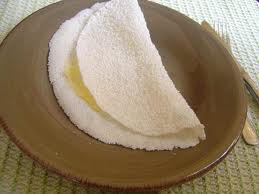Root vegetables such as cassava (locally known as mandioca, aipim, or macaxeira), yams, and peanuts and fruit like açaí, cupuaçu, mango, papaya, guava, orange, passionfruit, pineapple, and hog plum are among the local ingredients used in cooking. Brazilian pine nuts (pinhão) grown in a tree (Araucaria angustifolia) that is abundant in the southern part of Brazil, and are a popular national snack, as well as a lucrative export. Rice and beans are an extremely common dish, as are fish, beef and pork.
 Some typical dishes are caruru, which consists of okra, onion, dried shrimp, and toasted nuts (peanuts and/or cashews), cooked with palm oil until a spread-like consistency is reached; feijoada, a simmered bean-and-meat dish; tutu de feijão, a paste of beans and cassava flour; moqueca capixaba, consisting of slow-cooked fish, tomato, onion and garlic, topped with cilantro; and chouriço, a mildly spicy sausage. Salgadinhos, cheese buns, pastéis and coxinha are common finger food items, while cuscuz branco, milled tapioca, is a popular dessert. Brazil is also known for cachaça, a popular native liquor used in the caipirinha.
Some typical dishes are caruru, which consists of okra, onion, dried shrimp, and toasted nuts (peanuts and/or cashews), cooked with palm oil until a spread-like consistency is reached; feijoada, a simmered bean-and-meat dish; tutu de feijão, a paste of beans and cassava flour; moqueca capixaba, consisting of slow-cooked fish, tomato, onion and garlic, topped with cilantro; and chouriço, a mildly spicy sausage. Salgadinhos, cheese buns, pastéis and coxinha are common finger food items, while cuscuz branco, milled tapioca, is a popular dessert. Brazil is also known for cachaça, a popular native liquor used in the caipirinha.The European immigrants (primarily from Germany, Italy, Poland, Spain and Portugal) were accustomed to a wheat-based diet, and introduced wine, leaf vegetables, and dairy products into Brazilian cuisine. When potatoes were not available they discovered how to use the native sweet manioc as a replacement. Lasagna, gnocchi, yakisoba, and other pasta dishes are also very popular.
Traditional desserts
Fig, papaya, mango, orange, citron, pear, peach, pumpkin, sweet potato (among others) sweets and preserves, often eaten with solid fresh cheese and/or dulce de leche.
- Quindim
- Brigadeiro or negrinho
- Biscoitos de maizena (cornstarch cookies)
- Beijinho (coconut "truffles" with clove)
- Cajuzinho (peanut and cashew "truffles")
- Cocada (coconut sweet)
- Pudim de pão (literally "bread pudding", a pie made with bread "from yesterday" immersed in milk instead of flour (plus the other typical pie ingredients like eggs, sugar etc.) with dried orange slices and clove)
- Manjar (coconut pudding with caramel cover and dried plums)
- Doce de leite
- Arroz-doce or rice pudding
- Canjica (similar to rice pudding, made with white corn)
- Romeu e Julieta: Goiabada (Guava sweet) with white cheese (most often minas cheese or requeijão)
- Lemon pie (shortcrust pastry with creamy lemon-flavored filling)
- Pé-de-moleque (made with peanuts and sugar caramel)
- Paçoca (similar to Spanish polvorones, but made with peanuts instead of almonds and without addition of fats)
- Pudim de leite (similar to a flan, but done with condensed milk)
- Brigadeirão (a pudim de leite with chocolate or a chocolate cake)
- Rapadura
- Doce de banana (different types of banana sweets, solid or creamy)
- Maria-mole
- Pamonha (a traditional Brazilian food made from fresh corn and milk wrapped in corn husks and boiled). It can be savoury or sweet.
- Papo-de-anjo
- "Açaí na tigela" (usually consists of an açaí (Brazilian fruit) mixture with bananas and cereal or strawberries and cereal (usually granola or muslix)









No comments:
Post a Comment